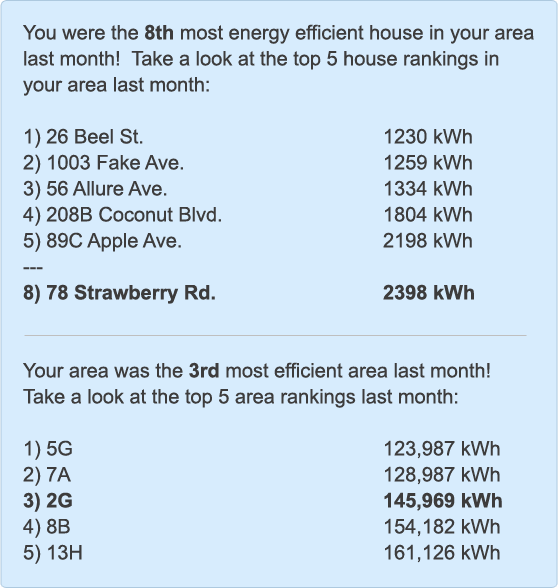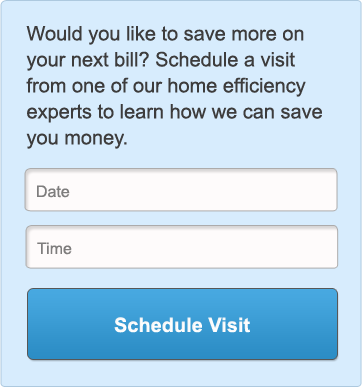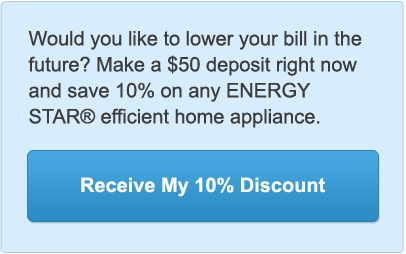When doing some computer house keeping a few weeks ago, I noticed I had many documents and reports related to persuasive technology and social psychology concepts in web applications. Rather than lay dormant on my hard drive in .docx files, I figured it would be more useful to share these ideas with others. People can expand on these ideas, adjust them, and perhaps move forward with them. I have adjusted this document to use less technical jargon and make it more suited for a blog.
The first idea in this series of blog posts is on the topic of energy consumption. The project explains how features of a web portal can be used to invoke behavior change through utilizing concepts in social psychology and persuasive technology. If you are not familiar with what a web portal is, you have likely already used a web portal before but are simply unfamiliar with the definition. A web portal is essentially a specialized website which requires a login and usually features a ‘dashboard’ of various modules displaying different types of information pertaining to the logged in user. The administration area of a content management system, online banking, even the Facebook home page can be considered a type of web portal.
This conceptual web portal will be for hydro (or electric energy) customers to login, pay bills, see account information, and see all the information discussed in this post. Various modules (think ‘sidebar boxes’ or sections of a webpage ) of this conceptual web portal will be crafted to have the ultimate goal of reducing energy consumption through behavior change. To explain more on what a module is, we can continue with the Facebook analogy; you can think of the events, messages, and news feed components of the Facebook home page as modules.
I have summarized how the different modules will work. Each has their own dynamics and characteristics as to how to address the issue of electric energy conservation in the house hold. A few notes about the following examples:
- When the examples are referring to houses or households, it really mean houses, apartments, or condos.
- The term API is used frequently. Learn what an API is here.
- For simplicity sake, when the term energy consumption is used it is referring to electric energy consumption in these examples.
- Some graphical interface concepts are used in the examples. For an real life implementation of these ideas the layout, font, colours, and controls will be refined and adjusted.
Creation of In-Group and Out-Group Dynamics
If you are familiar with social psychology or sociology, you are likely familiar with the concepts of in-groups and out-groups. Rather than explain that here, I think this page does a good job explaining the concept. The preceding link explains what happens to people’s behavior when they perceive themselves to be members of a team. This involves segmenting groups of houses in the energy service jurisdiction into areas. This module will display the following information:
- top 5 consumers of area in area
- bottom 5 consumers of area in area
- placement of area in hydro company jurisdiction
- progression/regression of progress from month to month of household and area
By segmenting houses into areas, it creates group dynamics and can create a feeling of ‘conforming to the group norm of conserving energy’ in it’s members. This can make people feel like they need to do this or they will be letting the group down. By displaying the rank of each area it can create an element of competition between groups. In order for individuals to maintain positive social perception within their area, they may try to reduce their consumption. Otherwise they may feel that they are ‘dragging the group down’ and possibly be perceived negatively. Just take a look at the importance of group dynamics in World of Warcraft to understand the importance of group dynamics in the online world.
A prize for top performing individual or area can also be introduced; some game mechanics from Four Square can be borrowed. In Four Square badges are awarded for performing certain tasks. Awards can be presented for most improved individual, being the most efficient area in a month, etc. The concept of being a ‘mayor’ can be borrowed and adapted.

Issues to Discuss and Comments:
One issues is how to make this new in-group salient in people (we are area 2B and we conserve energy!). One possible solution is to introduce team flags or logos, similar to a local sports team. If the Ottawa Senators or Toronto Maple Leafs were called ‘NHL team 4G’ and ‘NHL team 6H’ they likely would not have the same following they currently have.
Public Information
When people are aware that they are identifiable or that certain information about them will be made public, these people may alter their behavior to ensure they will be perceived positively by significant others (not necessarily in a romantic sense, but people that are important to that individual). By making the energy usage of households publicly available, it can influence them to to conserve more. They may not want to be viewed as wasteful or over consumers, or too lazy to put in the effort to conserve.
To display this information, this module can integrate with the Google Maps API to display the information and make it easy to determine the location of houses.

Issues to Discuss and Comments
There could be potential privacy issues of making energy usage of households public.
Anonymous Messaging
Households can send other houses in their area anonymous messages regarding their energy consumption. They can praise them for their improvement or sustained conservation efforts while ‘prodding’ for improvement from the highest consumers. The public information module previously discussed can give the information necessary to engage in discourse with another household. This will function very similarly to the Facebook messaging system.
Issues to discuss
This module does have the potential for abuse and can perhaps, be too extreme altogether due to the fear and paranoia in can create. There are all sorts of people and personalities out in the world. Take this possible message that could be sent:
‘Hi, I noticed you are using a lot of energy, can you conserve a bit more? By the way, I like what you have done with your front garden. Looks great! Would be a shame if something happened to it. Take care, I hope next month we can all do better with our conservation efforts. ‘
When people perceive their actions to be anonymous or untraceable to their real life person (such as in large crowds at stadiums for sporting events or online on comment sections) their behavior can become very abusive or hostile. Take a look at mob mentality and online flaming for more information. Although not exactly the same, they do share similar characteristics.
Overall this module can be quite powerful. It can be quite unsettling to know someone in your neighbourhood disapproves of your energy consumption but you don’t know who! But, for ethical reasons this may not be appropriate altogether to try and induce behavior change through fear and paranoia.
Add on Sales When Paying Bill
If you have read the book ‘Persuasive Technology’ by BJ Fogg you will be familiar with the Kairos factor. This involves trying to invoke an action in someone at an opportune time, when they are most willing. A similar concept also exists in sales and this is known as ‘up selling’. I think up selling can be ethical and genuine if done in the right way. If a sales person is honestly suggesting an additional product or service the customer may find useful, I see no problem with this. A module can be added to the web portal which provokes the purchasing of energy efficient products or services using the Kairos factor combined with the traditional ‘call to action’ in websites. The context of this module creates the opportune time to make these suggestions because:
- The user is already logged in to the portal, possibly already pursuing the task of paying their energy bill, credit card may already be out
- By seeing the information presented in the other modules, they could have negative feelings about their current consumption levels
The suggestions themselves can include:
- scheduling of a representative to stop by their home and asses efficiency
- offer discount on energy efficient appliances if a deposit is purchased at that moment
The end result of the module could look something like this:


Issues to Discuss and Comments
If individuals pay their energy bill directly from their online banking account, they may not be viewing the module at the right time, which is not ideal to take advantage of the Kairos factor.
Public Goal Setting
By publicly broadcasting a goal it makes us more likely to follow through with it. Plus, we avoid the consequence of of being perceived negatively from our peers. If we do not follow through, we will appear inconsistent with our intentions. This module will involve goal setting, and the broadcasting of these goals to their area (and possibly beyond this portal, broadcast on Facebook and Twitter with their APIs?). This module will also feature email reminders periodically during month to state the status of their goal and how close they are to going over their goal. This will be similar to monitoring how much bandwidth you are using with household internet use. The following points explains the steps as to how this module will work:
- The user sets a goal for their monthly energy consumption targets
- The user receives weekly email reminders regarding the state of their energy consumption
- At the end of the month the system determines whether they have reached their target or not and broadcasts the appropriate message to others in their area
- As mentioned in the first module, a virtual award or prize can be given if the target is met
Issues to Discuss and Comments
The module can be adjusted to borrow ideas and concepts from existing weight loss and heath goal, or charity and fundraising web applications.
Conclusion
All of these modules can be used, in their own way, to create behavior change. When they are used in combination they can have the overall maximum effect. The pros and cons of each module have been discussed but one overarching factor is the dynamics within the household. The people and mandatory energy requirements can vary greatly within a household. Some examples are:
- full house with 2 adults 3 kids
- 2 adults, kids are away at school
- 1 adult, kids away at school
- single apartment, person travels a lot for work
- single apartment, person works from a home office
- perhaps due to someone’s hobbies, medical conditions, or work, they require devices which use a lot of energy
As we can see, the amount of energy consumption in all of these scenarios will vary greatly. Perhaps it is a good idea to segment households into ‘leagues’ in order to make the competition aspect among the areas more fair.
Final Thoughts
In most cases, any company that builds web applications needs to ensure it has been analyzed from a psychological perspective if it is to be successful. As the web evolves, more disciplines become facets in successful web projects. Persuasive technology and social psychology is one of the more recent facets to be added.
Do you remember Facebook in it’s early years? It’s main competitor was MySpace. Both web portals had very similar technical requirements and on the surface, appeared to offer largely the same service. However, Facebook understood the social psychology as to why people were doing certain actions and what motivated them to do so. The features and components of Facebook revolved around this. In addition, Facebook cleaned up the majority of user experience problems that MySpace had. The end result: Facebook stole MySpace’s (almost) entire market from under their nose.
Leveraging persuasive technology and social psychology in web applications and web portals can be very powerful. In the examples discussed, it can also be used to create positive behavior change in the world.
